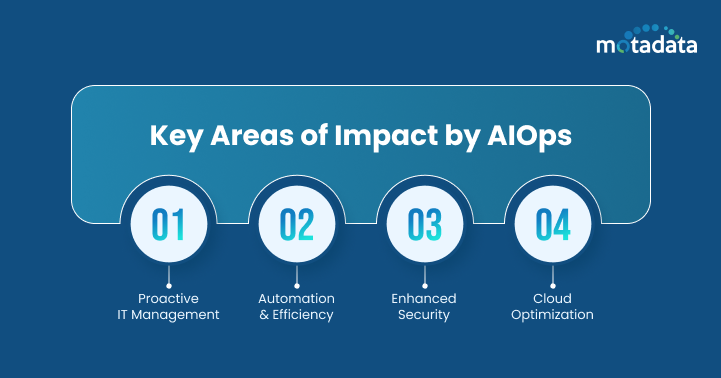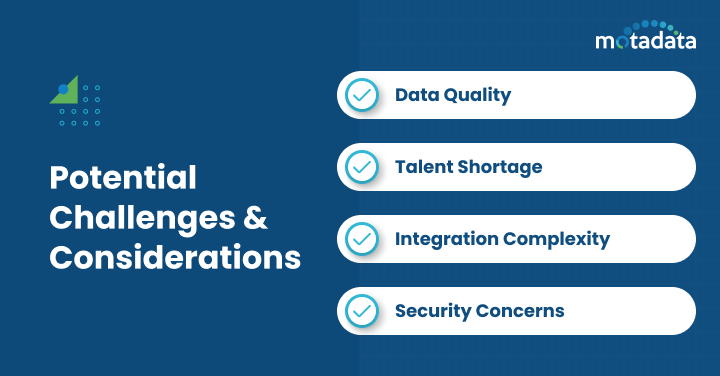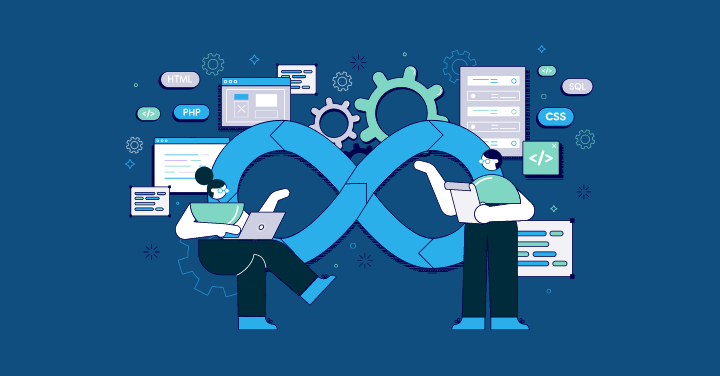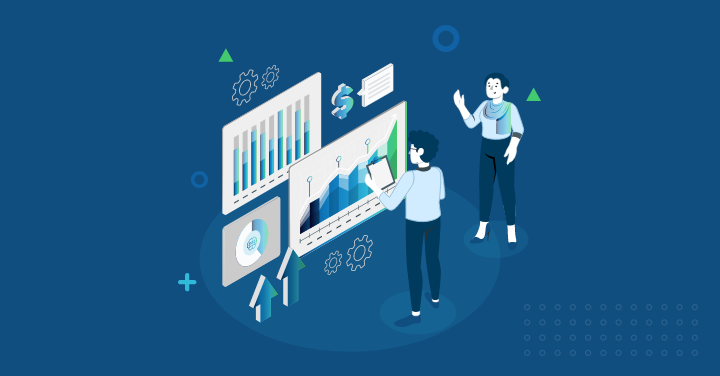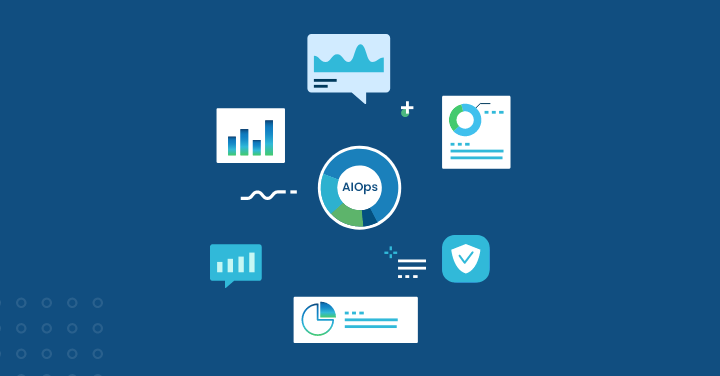Earlier businesses relied on traditional IT on-premises systems for smooth operations and performance management.
However, with cloud computing and digital transformation, businesses started gaining real-time insights and data from multiple sources.
As a result, managing such big data became more complex for the IT operations team.
Hence, to streamline all processes and manage the big data, AIOps tools were introduced.
The integration of advanced technologies into IT operations completely changed the game.
It allowed organizations to monitor historical and current data, detect anomalies in real-time, perform predictive analysis, automate tasks, and more.
Further, AIOps technologies allowed IT teams to generate intelligent reports that expedite the resolution of performance problems, contributing to an effective IT management system and improved customer experience.
Today, almost every other business uses digital technology in different business operations to deliver positive results to their clients.
It has become a crucial strategy to help you stay competitive and meet growing demands.
Many businesses adopted this best practice during the pandemic to keep their business running and earn revenue.
Some even continued remote working and grabbed a larger audience’s attention using innovative apps and internet channels.
By allowing companies to use AI for better IT operations, security, and resource management, adopting AIOps is anticipated to be a key factor in the success of digital transformation in 2025.
Let us learn more about the significant impacts and challenges of AIOps on digital transformation.
What are the Key Areas of Impact by AIOps?
For AIOps to work correctly, it needs a few vital components. The technology’s core components are machine learning and artificial intelligence.
Big data analytics processes massive volumes of data, and automation carries out actions using AI-driven insights.
Together, these elements form a sensitive and dynamic system. Let us understand the key areas that might positively impact this practice.
A. Proactive IT Management:
With the help of the AIOps platform, businesses of different sizes can help their IT teams manage technology proactively.
Earlier, IT teams used to take action after the problem happened, i.e., after the problem resulted in downtime or system disruptions.
This delay in problem detection and resolution could further lead to inefficiencies.
However, today, by using artificial intelligence, businesses can track and identify the problem at an early stage.
The AIOps solution comes with various capabilities. It allows IT teams and professionals to analyze big data collected from multiple sources and spot errors in real-time.
It runs machine learning algorithms to analyze chunks of data and spot patterns or unusual behavior.
For example, if you notice that your website is seeing a sudden spike in incoming traffic, AIOps will immediately send an alert notifying you about the unusual behavior.
By leveraging this proactive AIOps approach, IT teams can address critical problems before they cause any major damage.
With this approach, you might encounter fewer downtime issues and disruptions, making your services more reliable and a top option for most clients.
Further, with timely service delivery and smooth business operations, you can keep your customers satisfied and engaged.
Further, identifying anomalies and potential bottlenecks in IT systems helps improve overall IT performance.
B. Automation and Efficiency:
With the help of advanced data analytics and machine learning techniques, this solution helps make its IT operations more efficient by automating all the tasks.
Generally, an IT expert has to run regular log analysis, manage and monitor day-to-day incident tickets, detect issues in IT operations, and more.
All these tasks together may be quite time-consuming and won’t be possible with human intervention.
Additionally, it won’t allow your team members to make time to focus on other critical areas.
However, with the implementation of AIOps, all these general tasks can be automated thanks to artificial intelligence.
Whether running log analysis, managing incident ticks and prioritizing them, or identifying the root cause of a problem, everything can be eased out using AI.
With automation capabilities, your IT department can focus on other key areas and save time. Further, it will help reduce human error and efforts.
One of the major benefits of this automation is it allows team members to analyze big data collected from multiple sources in minutes.
It helps identify patterns and anomaly detection and their root cause in real time, thus enhancing your operational efficiency.
Further, it helps save your organization from putting their money into unnecessary costs and repair tasks that were earlier a part of the system due to frequent human errors.
Thus making IT operations more reliable and supporting efficient resource usage.
Read Also: Best Practices for Implementing an AIOps Platform
C. Enhanced Security:
Over the past few years, the cyber threat rate has tremendously increased. Attackers have been practicing various techniques to get into the IT systems and steal crucial files.
With time, these threats are becoming more advanced and spreading widely across different sectors.
Hence, ensuring security is crucial for all organizations adopting digital technologies.
AIOps is a widespread practice for IT operations that can improve security levels using machine learning and AI.
IT and DevOps teams can detect and prevent threats in real time using these techniques.
Further, the AIOps platform allows system administrators and security teams to monitor all the incoming traffic, system logs, and other data sources.
It applies predictive analytics and spots patterns such as unusual login attempts and transfers from/to unauthorized accounts.
With these actionable insights collected in real time, AIOps can take corrective measures automatically.
It may block harmful traffic or isolate the affected systems depending on the root cause of the issue, thus preventing financial losses and other damages.
Using AIOps for security, organizations can prevent data breaches in real time and reduce the risk associated with cyber threats.
A robust security system protects crucial files from reaching the wrong hands and builds trust among customers and stakeholders.
D. Cloud Optimization:
AIOps is transforming digital transformation by innovating cloud optimization, a critical component.
Managing and optimizing IT resources in intricate cloud settings is challenging without the right tools and approach.
However, by leveraging AIOps, organizations can benefit significantly from AI in managing and optimizing cloud environments.
These tools will allow users to monitor cloud resources in real-time and analyze their usage and performance.
Further, they help automate all operational tasks and save costs, thus ensuring the cloud infrastructure is used efficiently.
In the cloud context, this proactive strategy reduces downtime, optimizes resource use, and generates business outcomes.
AIOps is expected to revolutionize the efficient management and optimization of cloud resources by IT operations teams.
Read Also: AIOps in Telecom Industry: Challenges, Benefits, and Use Cases
Potential Challenges and Considerations
Undoubtedly, AIOps offers various benefits for digital transformation, but it also comes with various challenges that one must consider.
- Data Quality: AIOps tools use their AI and ML algorithms to collect data from multiple sources, but they might sometimes collect inaccurate or incomplete data. The quality of IT data is one of the biggest challenges for it may result in wrong predictions, poor analysis, and bad business decisions. Hence, it is crucial to run data quality audits, cross-check data collection methods, and implement data governance practices to overcome this difficulty.
- Talent Shortage: Users often face another big challenge: the required skills and talent to manage or run these tools. Hiring specialists with adequate IT operational knowledge and data science skills is challenging. To overcome this challenge, you can train your existing employees or conduct workshops to fill the talent shortage.
- Integration Complexity: Network devices, servers, apps, and security systems are just a few of the data sources that AIOps uses. Consolidating this data into an integrated and comprehensive platform can be difficult and time-consuming.
- Security Concerns: While managing sensitive data on this powerful platform, a few security problems might also arise. Illegal access or data breaches could compromise the data’s security and integrity. Therefore, the best action is implementing strong security procedures and safeguards to lower risk and guarantee data security. Additionally, you can run regular audits to identify system loopholes and prevent breaches.
What is the Future of AIOps in Digital Transformation (2025 and Beyond)?
IT operations are revolutionizing AIOps, and the field has many more exciting things in store.
As AIOps develops, significant gains in transparency, integration, and alignment with business objectives are expected.
It is anticipated that AIOps will keep expanding and driving digital transformation in creative ways until 2025 and beyond.
Businesses can improve their operational efficiency and deliver exceptional customer service by utilizing this technology.
It is expected to shift in the following ways in the next few years:
- Artificial Intelligence (AI): Excessive use of AI in IT operations will increase transparency for human users. The enhanced AI models and algorithms will boost system confidence, ease overall operations, and result in quick suggestions and decision-making. Further, by providing IT professionals with access to the underlying cause of the problem and AI-driven insights, organizations can empower them to make informed decisions and take appropriate action based on AIOps suggestions.
- Self-healing IT infrastructure: Thanks to generative AI, IT systems can handle problems without human interaction, generating new responses and alternatives to emerging difficulties. This capability can further improve the effectiveness and reliability of IT operations management.
- Integration with ITSM Tools: The integration of AIOps platforms with the current ITSM tools—such as incident, change, and service desk solutions—will be simple. By integrating traditional ITSM practices with advanced analytics capabilities, organizations can gain a more comprehensive view of IT operations analytics. It will further automate repetitive tasks, speed up problem discovery and resolution, and enhance overall IT services management, delivery, and efficiency.
- Autonomous and self-optimizing IT environment: AI and machine learning developments will make AIOps platforms more skilled at using lessons learned from previous crises to optimize IT operations. Through this ongoing learning and optimization process, IT environments will be able to accommodate the changing demands of digital enterprises by becoming more resilient and adaptive.
AIOps’s importance as a major factor in the success of digital transformation will only grow as it develops. Companies that use AIOps will be in a better position to handle the intricacies of the digital environment, using AI to optimize resources, boost security, and improve IT operations.
Conclusion
Looking forward to 2025 and beyond digital transformation status? Well! It is expected that AIOps will have a profound impact on digital transformation in the coming period.
Business dynamics have completely changed after integrating new and advanced technologies into the IT system.
AIOps allows users to manage IT operations, automate routine tasks, better optimize cloud resources, generate insightful reports, and more now proactively.
Businesses can use this robust platform to collect data from multiple sources and analyze it faster.
Further, it enables users to track unusual patterns, spot errors, and resolve incidents in real time.
The solution provides real-time updates and suggestions, be it a sudden spike in incoming traffic or any other unusual behavior.
In short, AIOps delivers increased productivity, faster incident response, and proactive problem-solving, all of which can be highly advantageous to any kind of business.
We have listed some of the key areas that might positively impact adopting AI and machine learning techniques.
You may tailor the platform to meet your specific needs and achieve better outcomes by defining your AIOps use cases and objectives.
You may stay ahead of the curve by following best practices, staying up to date with industry advancements, and continuously improving your AIOps approach, even when challenges like poor data quality and resistance to change may surface along the route.
Businesses hoping to have a successful digital journey must embrace this practice.
It will be a vital force behind innovation and growth as the digital landscape develops, helping companies maintain their competitiveness and provide value to their clients.
You can find several such tools in the market, but Motadata AIOps platform is one of the trusted in the market for it offers exclusive features.
It analyzes and transforms the data you’ve acquired into insights that can be implemented using AI/ML and intelligent automation.
It assists in locating the data that deviates from the norm and anticipated trends. Additionally, the platform adapts to your changing IT environment, whether you’re adding more servers, implementing cloud services, or introducing IoT devices.
Adapting the practice of AIOps has various benefits. Make sure to consider its challenges and future impact.
FAQs
There are several benefits to using AIOps for digital transformation, including:
- Allows IT Teams to manage a vast amount of data and prioritize them based on the impact severity
- Helps identify the root cause of an issue and provides insightful resolution
- Automates various IT operation processes and saves costs
- Streamlines routine tasks and increases operational efficiency
- Offers a consistent and uniform perspective of events and situations, which promotes collaboration
- Enhances security measures and optimizes cloud resources.
These advantages improve agility, simplify processes, and guarantee strong digital awareness for upcoming challenges.
Businesses may prepare themselves to implement AIOps by investing in a strong data infrastructure, equipping their IT personnel with the necessary expertise, integrating AIOps tools, and implementing a data-driven strategy.
When planning the strategy, be clear about your objective and ensure it pinpoints how AIOps will help amplify value in different sections.
Also, constantly seek feedback from the stakeholders.
Choosing an AIOps platform that can interact with current systems and offer extensive application performance monitoring, analysis, and automation capabilities is also crucial.
By improving the effectiveness and reliability of IT operations, AIOps can assist businesses in achieving their goals related to digital transformation.
AIOps helps organizations concentrate on strategic projects and innovation by offering real-time data analysis, enhanced security measures, proactive issue resolution, and automation of repetitive processes.
Digital transformation goals are further supported by enhanced security and efficient cloud resources.
Humans and traditional practices are no longer enough to manage the fast-paced, complex IT business environment in today’s world. Businesses are incorporating several tools and technologies to better manage IT operations.
AIOps is one such tool; it uses AI, automation, and machine learning practices to monitor and manage different aspects of an IT Management system.
With its help, users can identify issues in real time, automate incident response, enhance security measures, streamline processes, and better optimize cloud resources.
These developments result in IT environments that are more effective, reliable, and flexible, capable of meeting the changing requirements of digital enterprises.



